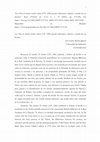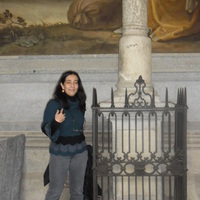Papers by Jose Carlos Martin
Studia Historica, Historia Antigua, 2023
Este artículo busca identificar la familia política de Fructuoso de Braga a partir del testimonio... more Este artículo busca identificar la familia política de Fructuoso de Braga a partir del testimonio de los tres poemas transmitidos al final de una Vita s. Fructuosi primitiva de autor anónimo, fuente de la Vita (CPL 1293) más extensa y conocida del santo. El estudio presenta una nueva edición y traducción de los poemas, dos de ellos atribuidos a Fructuoso y un tercero, en elogio suyo, de autor no identificado. Concluye que el esposo de Justa, de nombre Bricio, era hijo del rey visigodo Sisenando, mientras que el Visinando tradicionalmente considerado como tal fue el fruto del matrimonio de ambos. Asimismo, propone una identificación para el destinatario de los poemas de Fructuoso y otra, más hipotética, para el autor de la citada Vita s. Fructuosi primitiva, que con seguridad es quien compuso el tercer poema.
Veleia, 2023
El Excerptum Canonicum es una colección sistemática de 20 cánones incluida en la Recensión Julian... more El Excerptum Canonicum es una colección sistemática de 20 cánones incluida en la Recensión Juliana de la Hispana cronológica al final del Concilio VIII de Toledo (a. 653). Contiene siete entradas de tema judaico que incluyen un Canon 10 atribuido a un Concilio de Sevilla que se ha identificado tradicionalmente con el Concilio III de Sevilla. Este artículo trata de demostrar que el Canon 10 debe atribuirse a concilio hispalense anterior al Concilio II de Sevilla (a. 619) y fecharse hacia los años 616/7, un poco después del decreto de bautismo forzoso de la población judía de Hispania promulgado por el rey Sisebuto hacia el año 615.
Las Glosas Emilianenses y Silenses: Los textos latinos, C. García Turza, F. García Andreva (coords.), Madrid, Fundación San Millán de la Cogolla-Agencia Estatal Boletín Oficial del Estado, 2023, 2023
Este trabajo incluye la edición crítica y traducción del Paenitentiale Silense (CPL 1895) y de lo... more Este trabajo incluye la edición crítica y traducción del Paenitentiale Silense (CPL 1895) y de los textos, especialmente, homilías y la denominada Interrogatio de nobissimo, transmitidos en el manuscrito Madrid, Biblioteca de la Real Academia de la Historia, 60, que recibieron, respectivamente, las Glosas Silenses y Emilianenses. Las ediciones están precedidas de una presentación de los textos, con el estudio de los manuscritos y ¡la bibliografía esencial, y el análisis de sus fuentes.

Revista de Estudios Latinos, 2023
Las Institutionum disciplinae (CPL 1216) son un breve tratado de carácter pedagógico transmitido ... more Las Institutionum disciplinae (CPL 1216) son un breve tratado de carácter pedagógico transmitido bajo la autoría tanto de Isidoro de Sevilla como de Agustín de Hipona. Editadas por última vez en 1957, tras el estudio fundamental de Jacques Fontaine de 1968, hoy no caben dudas del carácter pseudoepígrafo de esta obra. Sin embargo, su origen sigue siendo discutido, pues mientras Fontaine propuso ver en ella un escrito carolingio, otros estudiosos han seguido defendiendo un origen visigótico. En este artículo, a partir de un nuevo estudio de sus manuscritos, sus fuentes, su posible contexto histórico y su recepción, se defiende que se trata, verosímilmente, de un escrito de origen toledano compuesto entre la difusión de las Etimologías de Isidoro de Sevilla y la epístola del duque Paulo al rey Wamba, esto es, hacia 632/3-673. El presente trabajo ofrece, además, una nueva edición crítica de esta obra y su traducción al castellano
Euphrosyne, 2020
This article describes the contents of three manuscripts of the Vitae sanctorum of Bernardo de Br... more This article describes the contents of three manuscripts of the Vitae sanctorum of Bernardo de Brihuega preserved in the General Historical Library of the University of Salamanca: 2538 (Books III and V of Brihuega), 2540 (Book IV: second part) and 2541 (Book IV: first part), and offers an alphabetical index of the authors and works gathered in these manuscripts and in MS 2539 (Book IV: third part; and Book II). The study highlights the importance of Vincent of Beauvais’ Speculum historiale as the main source of the Brihuega’s compilation.

Bachiarii Opera: De fide necnon Epistula ad Ianuarium, quibus accedunt Epistulae II quae eidem adtributae sunt. Praefationem historicam adiecit Roger Collins, 2019
Les quatre œuvres attribuées à Bachiarius (IVe-Ve siècle) ont en commun une exégèse très original... more Les quatre œuvres attribuées à Bachiarius (IVe-Ve siècle) ont en commun une exégèse très originale et des expressions qu’on a voulu mettre en relation soit avec le priscillianisme, soit avec l’origénisme. Le De fide est une profession de foi dans laquelle l’auteur se défend d’une accusation d’hérésie et expose ses idées sur la Trinité, l’incarnation, la virginité de Marie, la résurrection, l’âme humaine, le diable, les aliments, le mariage ou l’importance des deux Testaments. L’Epistula ad Ianuarium est un traité sur le péché, la pénitence et la rédemption, divisée en deux parties: la première dirigée à Januarius, le supérieur d’une communauté ascétique, en faveur d’un frère qui a commis un péché grave en ayant des relations sexuelles avec une vierge consacrée; et la seconde, au pécheur lui-même, qui, après avoir été expulsé de la communeauté, doit s’efforcer d’éviter le désespoir et de se faire pardonner au moyen de la pénitence. Les deux autres lettres qu’on attribue à Bachiarius présentent un style et une exégèse similaires: la première est dirigée à une vénérable sœur pleine de sagesse; la seconde, à une femme mariée qui souhaite se consacrer dans la solitude à des pratiques ascétiques pendant les trois semaines qui précèdent l’Épiphanie.

Revue d’Histoire des Textes, 2024
El tratado De trinitate (CPL 1200) atribuido a Isidoro de Sevilla es un catecismo sobre la Trinid... more El tratado De trinitate (CPL 1200) atribuido a Isidoro de Sevilla es un catecismo sobre la Trinidad conservado parcialmente en el manuscrito Madrid, Biblioteca de la Real Academia de la Historia, 78, donde se interrumpe bruscamente, mutilado por el final. En la versión que ha llegado hasta nosotros, está formada por 64 entradas que versan sobre las relaciones existentes entre las tres personas de la Trinidad, las diferencias entre la esencia, la sustancia y las personas, y las propiedades principales del Padre, el Hijo y el Espíritu Santo. Desde la edición de García Villada en 1933 no existía ningún estudio en profundidad de esta obra, que carecía, además, de un estudio detallado de sus fuentes, por lo que resultaba difícil proponer un origen y una datación precisos. En este artículo se ofrece una nueva edición de este tratado, muy diferente a la propuesta por García Villada, pues, gracias a la identificación de sus fuentes (fundamentalmente Agustín de Hipona y Fulgencio de Ruspe), han podido corregirse los numerosos errores de copia del único códice que la conserva. Además, a partir del estudio de estas mismas fuentes, se propone un origen mozárabe para este tratado pseudo-isidoriano, que podría haber sido redactado en la Córdoba del s. IX.
Fortunatae, 10, 1998
This study deals about the verbal morphology in the anonymous visigothic work Vitas Sanctorum pat... more This study deals about the verbal morphology in the anonymous visigothic work Vitas Sanctorum patrum Emeretensium. Clearly, the aim of the author is giving an inventory of non classical verbal uses and forms which were used currenthy, however, by a middle-cultured author who wrote in the visigothic Spain during the first half of the 7 th. century.
Mittellateinisches Jahrbuch. Internationale Zeitschrift für Mediävistik und Humanismusforschung, 2017
This paper contains the editio princeps, translation and preliminary study of four 6th century do... more This paper contains the editio princeps, translation and preliminary study of four 6th century documents from the Pyrenean monastery of San Martín de Asán –currently San Victorián (Sobrarbe, Aragon)– concerning the temporal patrimony of that institution. Among them, there are two pious donations given by the monk Gaudiosus and the bishop Aquilinus, and two royal decrees by the Visigothic kings Liuvigild and Reccared. The study addresses the analysis of documentary transmission, the description of its content and a linguistic characterization, which allow us to verify the authenticity of all four documents.
Estudio de la morfología verbal de las *Vitas sanctorum Patrum Emeretensium*, obra anónima de med... more Estudio de la morfología verbal de las *Vitas sanctorum Patrum Emeretensium*, obra anónima de mediados del s. VII, escrita en la Hispania visigoda.

Le Tractatus contra Iudaeos (Díaz 1214), dit aussi Qui ceptum, est une œuvre anonyme datée tradit... more Le Tractatus contra Iudaeos (Díaz 1214), dit aussi Qui ceptum, est une œuvre anonyme datée traditionnellement du XIIIe s. En effet, dans deux passages de cette composition, on lit que 1222 ans sont passés depuis la naissance du Christ. Or, dans un manuscrit inconnu des deux éditeurs du texte, le codex : Paris, BnF, lat. 2277, du XIVe s., qui transmet la Vita ss. Leandri, Isidori, Fulgentii et Braulionis (BHL 4810), on trouve une autre recension dudit traité (aux ch. 10-21), dans laquelle cet opuscule est daté de 760 et 766. L’étude linguistique des deux recensions du traité appuie cependant la date traditionnelle du XIIIe s., étant donné notamment qu’on y trouve des mots rares, comme « azebra, ae », « piscamen, inis » et « sustentamentum, i », qui ne sont pas connus avant le Xe s. De plus, la comparaison de la langue et du style du traité Qui ceptum et de la Vita Mahometi (Díaz 1215) copiée à la fin dudit écrit antijudaïque dans le codex Uncastillo, Colegiata de Santa María la Mayor, 10, du XIIIe s., suggère, contre ce qu’on croyait jusqu’ici, que ces deux opuscules ont été rédigés par deux auteurs différents.
Estudio de la tradición manuscrita de las obras de Braulio de Zaragoza. Publicado en La trasmissi... more Estudio de la tradición manuscrita de las obras de Braulio de Zaragoza. Publicado en La trasmissione dei testi latini del Medioevo. Mediaeval Latin Texts and their Transmission. Te.Tra. 1, P. Chiesa.-L. Castaldi (edd.), Firenze, Sismel-Edizioni del Galluzzo, 2004 (Millennio medievale, 50; Strumenti e Studi, n.s. 8), pp. 38-52.
En este artículo se estudian los procedimientos, especialmente los de estilo y los relacionados c... more En este artículo se estudian los procedimientos, especialmente los de estilo y los relacionados con los tópicos bíblicos y de vidas de santos, de los que se sirve Sisebuto para caracterizar a los dos antagonistas principales que sostienen el conflicto que nos plantea en su obra: San Desiderio y los reyes Teodorico y Brunequilda. La conclusión es que la Vita Desiderii responde perfectamente a los tópicos esperables de la hagiografía.
This paper offers the editio princeps of two medieval works about the passion of St Zoilus of Cor... more This paper offers the editio princeps of two medieval works about the passion of St Zoilus of Cordoba under Diocletian, and the invention and tranfer of his relics in VIIth Century. One of them is transmitted by Madrid, Biblioteca de la Real Academia de la Historia, 9, and the second one by Leon, Archivo de la Catedral, 52. The scholar surveys also the relations between these stories and the work of Rodolfo de Carrion about Zoilus of Cordoba transmitted in Madrid, Biblioteca Nacional, 11556.
Estudio de la relación existente entre los Chronica de Isidoro de Sevilla y la versión reducida d... more Estudio de la relación existente entre los Chronica de Isidoro de Sevilla y la versión reducida de esa misma crónica que se lee en el libro V, cap. 39, de las Etymologiae a la luz del stemma codicum de los Chronica.
This paper presents the authors and writings cited by Isidore of Seville in his De uiris illustri... more This paper presents the authors and writings cited by Isidore of Seville in his De uiris illustribus and study the use of them made by the bishop of Seville in the rest of his works. The conclusion is that the catalog of illustrious men is one of the oldest works of Isidore or perhaps the oldest.
This article provides the editio princeps of the annalistic compilation transmitted by the manusc... more This article provides the editio princeps of the annalistic compilation transmitted by the manuscript Madrid, Biblioteca Nacional, 18060. These records were made probably in the city of Barcelona around the year 1323, in the time of James II of Aragon. Furthermore the scholar translates the work and analyzes the accuracy of the historical information it conveys.
In this paper, we analyze the perception of the figure of Isidore of Seville (+ 636) in Medieval ... more In this paper, we analyze the perception of the figure of Isidore of Seville (+ 636) in Medieval Spain from his death until the XIIIth Century by menas of all the Latin compositions consecrated to his memory in hagiographic or homiletic genre, or in *De uiris illustribus* treatises. With his aim, we stablish the corpus of all the remaining Latin works written in Medieval Spain about the Sevillian bishop, indicating the critical editions of these texts of their manuscript tradition, if there is not a critical edition. Then we study the image of this Spanish saint in these compositions, their sources and their reciprocal relations. This survey makes possible to determinate the place where the anonymous works were written and to establish their approximate date.
The Chronicle of the Dominicans of Majorca is an annalistic compilation written partly in Latin a... more The Chronicle of the Dominicans of Majorca is an annalistic compilation written partly in Latin and partly in Catalan and preserved by the manuscript Palma de Mallorca, Archive of the Kingdom of Majorca, C-4739, XVIIth C., ff. 38r-41v. The oldest news (in Latin) dates back to 985, while the most recent (in Catalan) corresponds to 1552. G. Llabrés edited the work in 1909, but he did not faithfully reproduce the manuscript, because he organized the news chronologically and corrected grammatically both the Latin text and the Catalan. This paper offers the first faithful edition of the original text, study its contents and provides a linguistic analysis of the news in Latin.
In this paper the scholar offers the first really critical edition of the Epitaphium Leandri, Isi... more In this paper the scholar offers the first really critical edition of the Epitaphium Leandri, Isidori et Florentinae (ICERV 272), founded on all existing manuscripts. He examines too the textual tradition of this work and analyzes his metrical and linguistic properties.











Uploads
Papers by Jose Carlos Martin